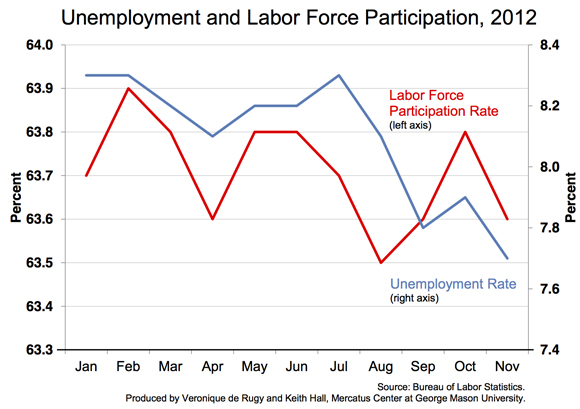- | Government Spending Government Spending
- | Data Visualizations Data Visualizations
- |
Shrinking Labor Force Participation Responsible for Most of the Drop in the Unemployment Rate
The minor improvement in the unemployment rate, however, is entirely due to shrinking labor-force participation. The labor-force disagreement has lowered the participation rate by 0.4 percentage point this year alone and affects pretty much every category of worker with the exception of 55 and older. So, while we have had some encouraging hiring this year, this drop in labor-force participation exaggerates the progress shown in the drop in unemployment rate.

Recent job numbers show an added 146,000 jobs in November and an unemployment rate of 7.7 percent, down from 7.9 percent in October.
The minor improvement in the unemployment rate, however, is entirely due to shrinking labor-force participation. The labor-force disagreement has lowered the participation rate by 0.4 percentage point this year alone and affects pretty much every category of worker with the exception of 55 and older. So, while we have had some encouraging hiring this year, this drop in labor-force participation exaggerates the progress shown in the drop in unemployment rate.
More discouraging is the fact that 40 percent of those still looking for work have been unemployed for more than 6 months. We still have a long way to go to a full-blown recovery.
As Keith Hall noted elsewhere, “[t]o know what kind of job growth we need for economic recovery, we must first realize that the United States is still a growing nation. Each month, the working-age population grows by an estimated 180,000 people. Simply to support this growing population, we need to add at least 130,000 new jobs. With anything less, we fall further behind. No matter what the other economic data indicates, a true labor market recovery requires job growth strong enough to consistently raise the employment-to-population ratio. This would mean adding at least 250,000 new jobs per month, every month, for years.”


